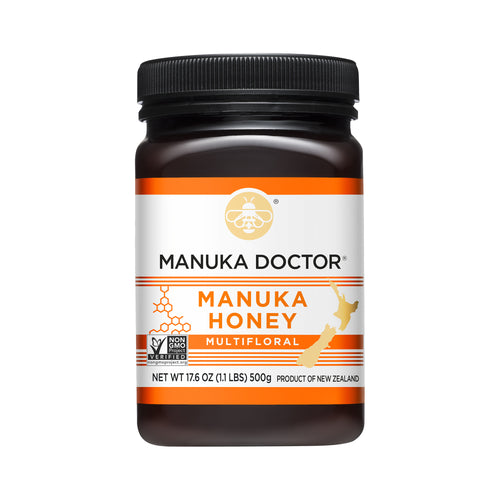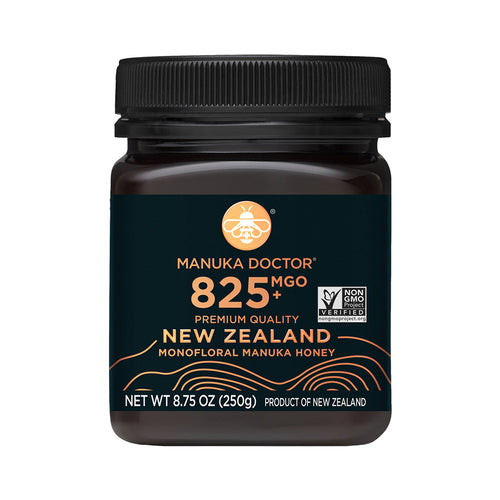Read Time: 4 minutes
Summary:
The process of making Manuka honey is a remarkable collaboration between nature and bees. In New Zealand, European honey bees work in perfect harmony to collect nectar from the Mānuka bush, which only blooms for a few weeks a year. Inside the hive, this nectar is transformed through enzymes and evaporation into the potent, antimicrobial-rich honey we know as Manuka. With careful beekeeping practices that prioritise hive health, bees thrive — producing more than enough honey to share, while keeping their colony strong.
Inside the Hive
We all know honey is made by bees - but have you ever considered how and why they do it? I wanted to find out exactly what bees do to make Manuka honey so I met bee behaviour expert Dr Megan Taylor so she could show me the process in all its sticky glory...
I meet Megan, Manuka Doctor’s honey bee programme director, in a rural New Zealand field which is home to a handful of the 10,000 hives owned by the company across the country. I’m anxious about approaching a hive buzzing with thousands of bees but Megan points out that they’re far from threatening, instead they’re peacefully ignoring us as they go about their business collecting nectar. “People mistakenly think the buzzing is a threat but actually it’s just the sound of them responding to the fact it’s a beautiful, sunny morning and the hive is warming up,” she explains.
Although we’re in New Zealand, the small golden-coloured bee zooming all around us is actually the European honey bee, a species which was brought to the country by European settlers in the 19th century and has lived happily here ever for more than 150 years.
Try a new Manuka recipe today!

Megan gently squeezes a few puffs of wood smoke into the hive from a handheld smoker – a traditional technique to calm the bees – and delicately levers off the roof. The hive is formed from a stack of wooden boxes containing handmade frames. These frames are filled by perfectly hexagonal wax cells in a “honeycomb” shape, built by the bees with astonishing precision.

A Day in the Life of a Bee
Each hive is home to a colony of around 40,000 to 60,000 bees and is the place they live, breed and make honey. The colony works as a “superorganism” – it acts as one being, made up of thousands of individuals. Every single one of the thousands of bees in the colony has a role which helps the group keep clean, healthy and efficient at making and storing honey.
Megan lifts up a frame from the centre of the hive - where the queen lays her eggs – and points excitedly at a cell where a bee is hatching. The young worker bee slowly crawls out into the hive to begin her 40-day life. Her work will start with simple tasks like cleaning cells and feeding young before building up to the most important role of all: collecting Manuka nectar to make honey.

From Nectar to Honey
All worker bees are female and go through a series of different roles within the hive until they are old enough to go out and seek the nectar, pollen and water which are vital for the hive’s survival, Megan explains. We watch as workers heavily laden with balls of bright yellow pollen return to the hive and crawl into its entrance, carrying Manuka nectar in a special compartment inside their mouths.
Lifting out another frame from the top of the hive, which is separated from the breeding area at the bottom, she shows me how a group of worker bees are storing Manuka nectar which has been mixed with naturally-produced enzymes. Another group of bees working together fan their wings to evaporate water from the stored nectar, which increases its sugar content and turns it into honey. The whole process triggers the natural chemical reaction which activates the special anti-microbial properties found only in Manuka honey1.
Bees feed on honey – it’s their source of carbohydrate – and pollen, which provides protein. “Bees expend so much energy working hard they need to have a really high-quality diet,” Megan says. “That’s why they will fly further for the best nectar if necessary. Manuka is a great source of high-quality nectar and that’s why they go for it. It only flowers for a few weeks a year, so when it does, it’s all hands on deck in the hive to make sure they gather as much of its nectar as possible.”
I ask what happens to the bees if we take the honey from them – surely they need it to eat? “Bees are nature’s overachievers - they stockpile and make far more than they need, leaving plenty for us,” Megan reassures me. It’s also down to considerate beekeeping. She explains that Manuka Doctor’s beekeepers take care to feed the bees, leave enough honey for them to eat over winter and make sure they are healthy. For the team, the health of the hive is the main priority because the healthier the bees, the better able they are to make quality Manuka honey.
Read more: Dr Fred's top 5 secret ingredients for good health, naturally
Sources:
1. Grainger M, Owens A, Manley-Harris M, et al. Kinetics of conversion of dihydroxyacetone to methylglyoxal in New Zealand mānuka honey: Part IV – Formation of HMF. Food Chemistry. 2017;232:648-655. https://doi.org/10.1016/j.foodchem.2017.04.066





